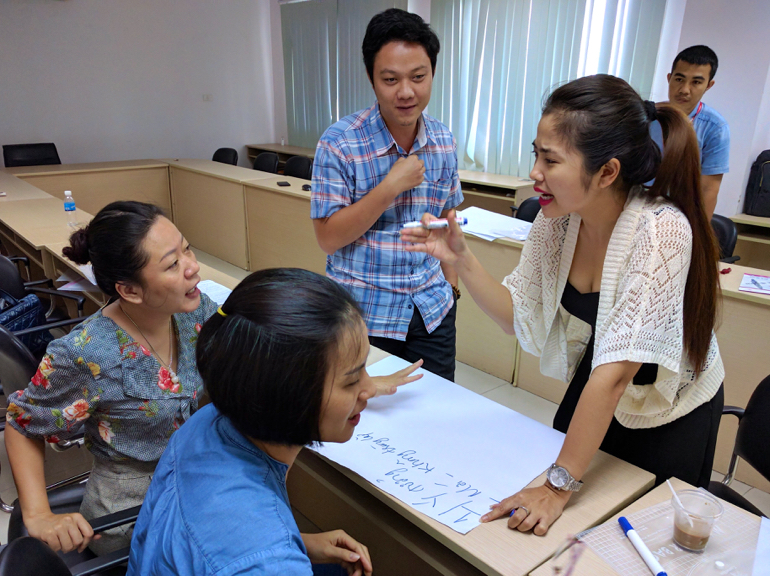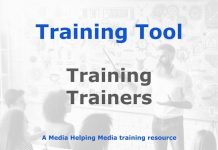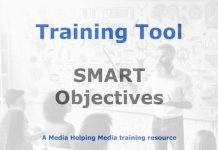
One of the first steps in delivering training is to articulate the ground rules. Participants need to know what to expect, what is expected of them and how you intend to schedule course elements.
They also need to know what is expected of them in terms of their participation and behaviour. The following tips set out some of the basics for delivering a training event.
Establish the ground rules
Soon after welcoming participants and making the introductions you will need to set out how the event will be run. This is where you make sure participants understand the course objectives, what you see as the deliverables, and their part in in the process.
You need inject a sense of urgency and set deadlines. Participants need to know that you mean business and that the course is not a break from work, or a couple of days off, but that it is a key part of their development and that of the organisation they work for. It is important to make this clear at the start in a friendly but firm way.
Go through the basic housekeeping points – arrival times, break times, venue layout including washrooms and emergency exits, rules on the use of mobile phones, smoking, talking etc. It all sounds basic and obvious, but getting such questions out of the way early is important to the smooth running of the event.
If you are intending to write about the event in a report, in a blog or via any social networking platforms you need to let people know. If you are planning to take pictures or video of the event you will need their agreement first.
Your material
You need to rehearse what you are going to deliver at least once and make sure your script matches your slides.
Check that nothing has changed overnight in terms of industry developments. Go online to read industry media coverage. Look out for new developments, statistics, changing audience behaviour.
Take time to inject and information that is relevant. If you don’t have time to update your slides consider projecting a web page with any new information and discuss the implications with the group.
They will appreciate the fact that you are keeping your material up-to-date and that you are continually on the look out for new developments.
Keep your slides brief, preferably rich in images and thin on words. Never just read from slides. If you have to repeat some bullet points ensure you have added value material in your head. There is nothing worse than being read to.
The technology
If you are using a projector, make sure there is a spare light bulb as backup just in case one blows. Check there is an extension lead with two outlets, one for the projector and one for the laptop.
Make sure there is a table for the projector and a screen for the presentations. Check the distance. Can it be viewed from the back of the room?
If you have audio, make sure there are speakers and that they work. If you have translation and group discussions check the microphones and any translation equipment has been set up and is in working order.
Always deliver a checklist of what you require to the organisers of the event well in advance and never presume everything will be in place – often it won’t.
And always be ready to run a session without a projector in the event of a power cut. Your training must not be dependent on technology and you need to be able to continue when all around you is falling apart.
Room layout
You will notice a massive cultural difference in terms of room layout from country to country. Some like rows of chairs facing the front, others like desks set out in rows, some like a horseshoe layout with the presenter in the middle and towards the front.
Make sure the layout is conducive to your style. A horseshoe layout can prove helpful for group participation and discussion.
The room needs to be set up before participants arrive – you should not be moving chairs as they gather for the event.
Check which way the room faces and whether there are blinds on the windows. You should make sure the sun doesn’t shine across your screen or in the eyes of the participants.
Welcoming participants
It is always nice to arrange for tea and coffee to be available as participants arrive for the first day of the event. If your training is due to start at 10am, invite people for refreshments at 9:30am.
As they turn up be friendly but don’t engage in conversations. Tell them politely that you will talk to them at the next break but that you must prepare.
Allow them to mingle. A neat trick is to have an envelope for each participant with details of the first icebreaker. Ask them to interview another participant over the first tea or coffee and jot down some notes.
Then, when the session starts, each participant introduces the person they interviewed. This is a great way of breaking barriers and developing friendships within the group.
Facilities
It’s always a good idea to have pens and notepads for participants. You will need a flip chart with plenty of pages for use in the group and individual presentations. Some adhesive for attaching paper to walls is useful. A whiteboard can come in handy. Make sure you have enough marker pens for both the flip chart and the white board. Sticky notes are useful for presentations.
Check whether there are any breakout rooms for the interactive exercises when participants break up into groups.
Arrange for name plates to be set up in front of each participant with their first name in large bold letters and their title and media organisation. You will want to be on first name terms as soon as possible. If you can arrange to have name badges, too, that may help – especially if you have a large group and a poor memory.
Refreshments
Always have drinking water available for participants. A tea/coffee break in the morning and the afternoon is a good idea – perhaps two in each session.
It is sometimes nice to have a refreshment table in the room where people can recharge their energy levels (even during the event). This sends out the message that participants are not trapped and that your sessions are working events.
Smokers may become restless if they are away from nicotine too long, so make sure you accommodate them, too. Check if there is a smoking area.
If refreshments are available at all times you can integrate breaks into the group interactive sessions so that participants continue to work as they drink.
Also remember that some participants will need to make personal calls and send texts and emails for business reasons. If you have sufficient breaks they can plan to do their personal and business communications between sessions.
Be available to chat during the refreshment breaks – you may pick up important information that you may be able to use in the sessions
Be well organised
Have a course outline available for participants at all times. It shows participants that you mean business and it helps them plan their lives around the event.If you change the course running order be sure to tell participants why.
Arrive early and set up immediately. Say hello when people arrive but only chat when you have set up.
When you start, tell people what they are going to be told and how the training will work. Tell them what you expect from the event and explain what will be expected from the participants. A slide setting out the course objectives is useful – you can use it again at the half-way point and at the end of the event to assess whether any progress has been made.
If you are planning any assignments, both during and between sessions, you will need to make this clear so that participants can set aside enough time.
Overnight assignments should not be time-consuming but should be something participants can think about on the train, bus or in the car.
Inviting them to think through three examples of an issue is an ideal form of overnight assignment which they can all report back on during the first session of the following day. The reason for using this technique is to ensure they continue to think about the event as they travel home and on their return journey the next day. It also gives you a flying start the following morning.
Activities
Keep participants active. The session should not be about you talking at them. It’s about engaging the audience, allowing them to participate and ensuring that they take ownership of the event.
Icebreakers (games to help people participate), energises (more games for the times when energy levels are dropping – usually after lunch), individual presentation and group presentations and group discussions and debates, are all important tools that can help lift a training event.
For example, if people are looking tired it is always good to call a short break and ask them to write down three does and three don’t from the session you have just delivered and ask them to present their six points in 30 seconds after the break. This will give you a great piece of feedback on whether the information was understood.
Understand your audience
Generally, when the training begins, you will have three types in the audience.
- Enthusiasts:
- You will have those who are genuinely interested in the topic being covered and will have made a special effort to attend.
- They will be the enthusiasts who could be great assets and contribute to the success of the event.
- Vacationers:
- You may have a couple of vacationers – those who are there because it is a chance to have a day off work.
- Their attitude will be one of contributing the least amount of effort possible.
- They will be polite, usually quiet although appearing attentive, contribute little and ask few questions.
- Prisoners:
- Then there are the prisoners who have been sent by their line manager to make up the numbers.
- They have no desire to attend your session and will be determined not to contribute.
- They will typically be texting friends, the first to stand up when a break is called, the last to arrive in the morning and the first to leave in the evening.
Your job will be to win over the vacationers and the prisoners and to involve the enthusiasts fully. It’s a delicate balancing act. Your aim, by lunchtime on day one, is to have everyone fully engaged and enthusiastic about the training.
You will also need to acknowledge the following participant types:
- The activists – those who like to do
- The reflectors – those who like to review
- The theorists – those who like to think things through and reach a conclusion
- The pragmatists – those who like to plan
All have a part to play in the sessions if managed well.
These characteristics will have been identified by your course questionnaire (embedded in the module Maximising the impact of media training) which you will have sent out prior to the course or which you will have introduced during the first session.
Disruptive behaviour
You will need a strategy for dealing with disruptive behaviour. Shouting does not work, neither does ignoring it.
If someone is repeatedly interrupting the event you could acknowledge their question but make it clear that there will be a chance for discussion before the next break.
If someone is continuing to cause problems you can take them aside and talk to them over the next tea break. At that point you will need to find out what is concerning them.
You may decide that they have some good points to make and consider involving them in helping with the event. You may deduce that they have no interest in the event and don’t want to be there. If you feel there is no value in them remaining in the group you may need to consider asking them to leave.
Ignoring disruptive behaviour will annoy those participants who mean business. They will see it as a sign of weakness and you may lose their attention, too
Plagiarism
Never steal another trainer’s presentation. Not only is it unethical, but it is also dangerous. If you have not written the training and thought through every point you may fall flat on your face when challenged – or worse, end up in court.
Your material must be all your own work. It must be original, unique, stimulating, mind-stretching, relevant, every-changing and fresh.
If you use quotes from other trainers be sure to reference them, acknowledge them for their value and, if possible, provide links to the original work.
Material
You should consider having the following course material available for all participants.
- Outline – why it is taking place and what it is designed to achieve.
- Timetable – refreshed each day and detailed down to the comfort breaks.
- Handouts – printed versions of the main points of each presentation.
- Slides – some participants will want to download your slides.
- Business cards – your contact details should participants want to follow up.
Feedback
Allow enough time for participants to fill out the course feedback form.
They are the people who will deliver the results of the work you have researched, designed and delivered. And you will be evaluating the success of your intervention by analysing how their behaviour changes and what those changes mean to the media business.
With some participants you will be establishing an ongoing working relationship. Ensure you acknowledge those who participated positively and enthusiastically.
Thanking the group
Always say thank you to participants at the end of the event. Without them it wouldn’t have happened.
They are the people who will deliver the results of the work you have researched, designed and delivered. And you will be evaluating the success of your intervention by analysing how their behaviour changes and what those changes mean to the media business.
With some participants you will be establishing an ongoing working relationship. Ensure you acknowledge those who participated positively and enthusiastically.








